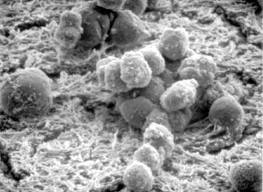Metabolism is the combined sum of the chemical reactions that occur in living organisms. Metabolism is traditionally divided into catabolism, or the breaking down of large molecules into smaller ones, and anabolism, or the combining of small molecules to make larger ones.
Metabolic pathways are coordinated series of reactions, catalyzed by enzymes and designed to make specific products. As a general rule, catabolic pathways provide energy and reducing power to the cell, while anabolic pathways consume energy and reducing power.
Not every metabolic pathway that occurs in an organism occurs in every cell. Some pathways take place only in specific cellular locations or in specific organs or tissues.
In a living cell, molecules flow through each metabolic pathway at some rate, called the flux. For the cell to function efficiently, it must be able to change the flux of molecules through each pathway. Control of flux is achieved by altering enzymatic activity, and usually several different enzymes contribute to control of the overall flux through a pathway. In addition, flux through a pathway can be influenced by the concentrations of metabolites in that pathway, such as the starting material.
Typical metabolic pathways contain some reactions with ΔG near zero under physiological conditions, and a few reactions that have a very negative value for ΔG. The former reactions are at or near equilibrium.
Because enzymes can operate in either direction, relatively small changes in substrate concentration can change the net flow of substrates forward or backward through these reactions. Such reactions are said to be reversible.
Metabolic reactions with large, negative ΔG are said to be irreversible. The ΔG of the reverse reaction is so large and positive that normal fluctuations in metabolite concentration do not make the reverse reaction occur to any substantial degree.
For such a reaction, the cellular ratio of reactant to product is much higher than would be seen if the reaction were at equilibrium. Thermodynamically speaking, irreversible reactions drive metabolic pathways forward.
Because they are far from equilibrium, irreversible reactions are optimal points at which to control the flux through a metabolic pathway. For example, doubling the enzyme activity could increase the rate of the forward reaction substantially, but would have little effect on the rate of the reverse reaction (which was very close to zero to start with).
Frequently, the first reaction in a metabolic pathway or after a branch point is irreversible and the enzyme that catalyzes it is a target for metabolic control. Altering enzyme activity occurs by many mechanisms and on time scales ranging from seconds to days. Here, I will mention two important mechanisms used to rapidly change enzyme activity: allosteric regulation and covalent modification.
A key longer-term mechanism presented in Topic 22 is regulation of the amount of enzyme present in the cell by controlling its synthesis and degradation.
Allosteric regulation
Enzymes influenced by allosteric regulation (“allosteric enzymes”) can bind molecules at sites other than the active site. Binding of these molecules causes conformational changes in the enzyme that increase or decrease its activity. For example, the glycogen phosphorylase found in muscle is an allosteric enzyme.
This homodimeric enzyme breaks down glycogen by removing one glucose monomer at a time. In addition to its active site, glycogen phosphorylase has an allosteric site that can bind AMP, ATP, or glucose-6-phosphate (G6P).
Binding AMP at the allosteric site favours an enzyme conformation with high activity; binding ATP or G6P favours a conformation with lower enzyme activity. (We will discuss more details of glycogen regulation) Another example of an allosteric enzyme is aspartate transcarbamoylase, the first enzyme in the pathway of pyrimidine synthesis. This enzyme is inhibited by CTP.
This is an example of feedback inhibition, in which a metabolite in a metabolic pathway (usually an anabolic pathway) inhibits an enzyme that functions earlier in the pathway.
Most allosteric enzymes have multiple subunits, and many have separate catalytic and regulatory subunits (i.e., the active site is on one subunit and the allosteric site(s) are on another). Note that allosteric inhibition is different from competitive inhibition, in which a molecule resembling a reactant or product binds to the enzyme’s active site.
Covalent modification
The activity of an enzyme can also be altered using post-translational modification, or the covalent attachment of chemical groups to the enzyme at particular amino acid residues. Adding or removing these chemical groups changes the conformation of the enzyme, affecting activity. For some enzymes, the modified form is the active form, while for others, the unmodified form is more active.
One group that commonly regulates enzyme activity is phosphate (‑PO32-), which, in eucaryotes, is most frequently added to the hydroxyl group of serine, threonine or tyrosine residues.
The phosphorylation state of a target enzyme is controlled by the competing activities of a protein kinase, which adds phosphate, and a protein phosphatase, which removes phosphate.
Phosphorylation is frequently used to transmit and amplify signals from outside the cell to the nucleus to control gene expression. Improperly controlled phosphorylation is often implicated in the development of cancer.
Armed with this information about metabolic pathways, we are now in a position to study the major processes by which humans extract energy from biomolecules.

